CHEVROLET CORVETTE 1993 4.G Owners Manual
Manufacturer: CHEVROLET, Model Year: 1993, Model line: CORVETTE, Model: CHEVROLET CORVETTE 1993 4.GPages: 370, PDF Size: 21.43 MB
Page 191 of 370
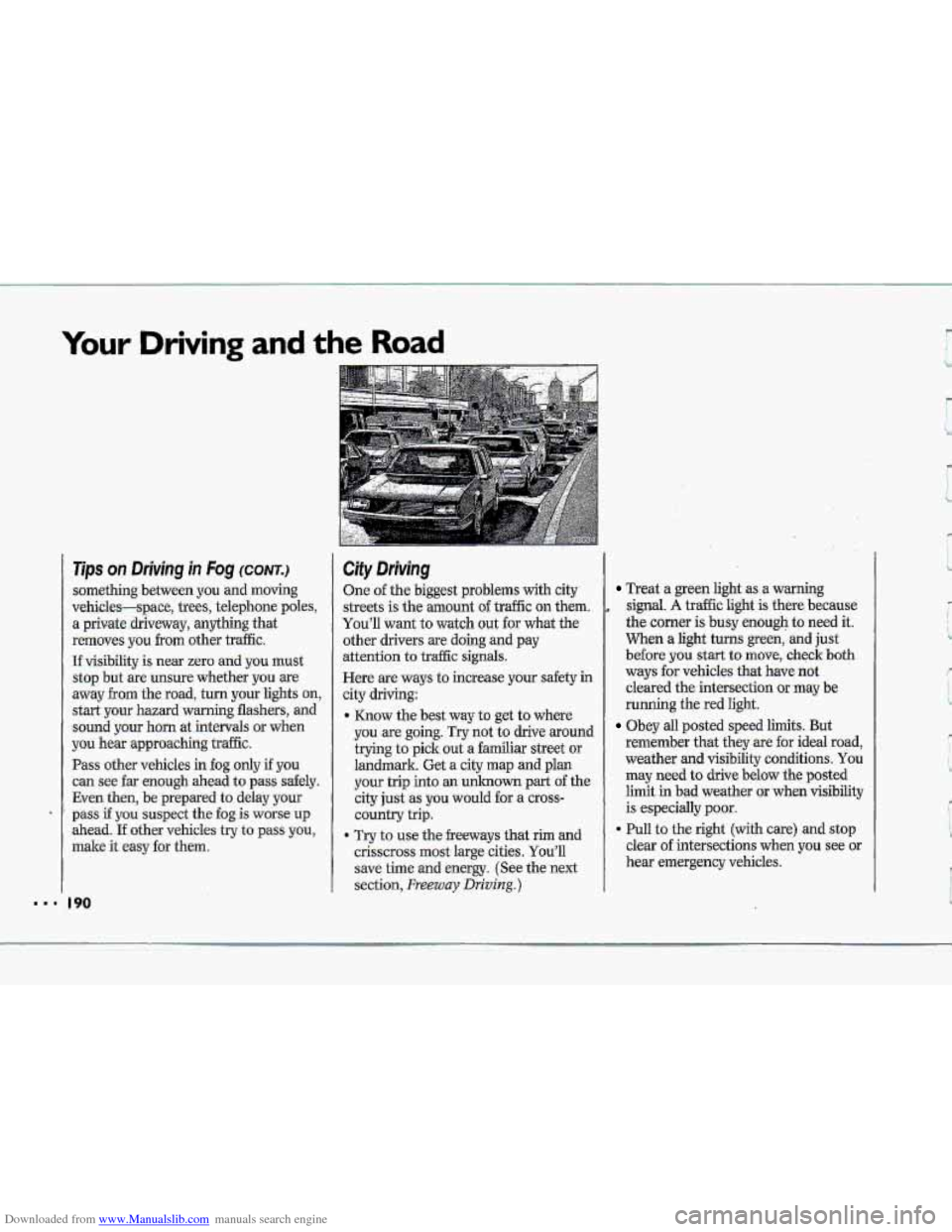
Downloaded from www.Manualslib.com manuals search engine Your Driving and the Road
Tips on Driving in Fog (CONT.)
something between you and moving
vehicles-space, trees, telephone poles,
a private driveway, anything that
removes you
from other trafic.
If visibility is near zero and you must
stop but are unsure whether you are
away
from the road, turn your lights on,
start your hazard warning flashers, and
sound your horn at intervals or when
you hear approaching traffic.
Pass other vehicles in fog only if you
can see far enough ahead to pass safely.
Even then, be prepared to delay your
pass if you suspect the fog is worse up
ahead. If other vehicles try to pass you,
make it easy for them.
City Driving
One of the biggest problems with city.
streets
is the amount o€ traffic on them.
You’ll want to watch
out for what the
other drivers are doing
and pay
attention
to traffic signals.
Here are ways to increase your safety in
city driving:
* Know the best way to get to where
you-are going.
Try not to drive around
trying to pick out a familiar street or
landmark. Get a city map
and plan
your trip into an unknown part of the
city
just .as you would for a cross-
country trip.
9 Try to use the freeways that rim and
crisscross
most large cities. You’ll
save time
and energy. (See the next
section,
Freeway Driving.)
Treat a green light as a warning
.signal, A traffic light is there because
the corner
is busy .enough to need it.
When a light turns green, and just
before you start to move, check both
ways for vehicles. that have not
cleared
the intersection or may be
running the red light.
Obey all posted speed limits. But
remenher that they are
for ideal road,
weather
and visibility conditions. You
may need to drive bglow the .posted
limit
.in b.ad weather or when visibility
is especially poor,
clear
of intersections when you see or
hear emergency vehicles.
9 Pull to the right (with care) and stop
c
Page 192 of 370
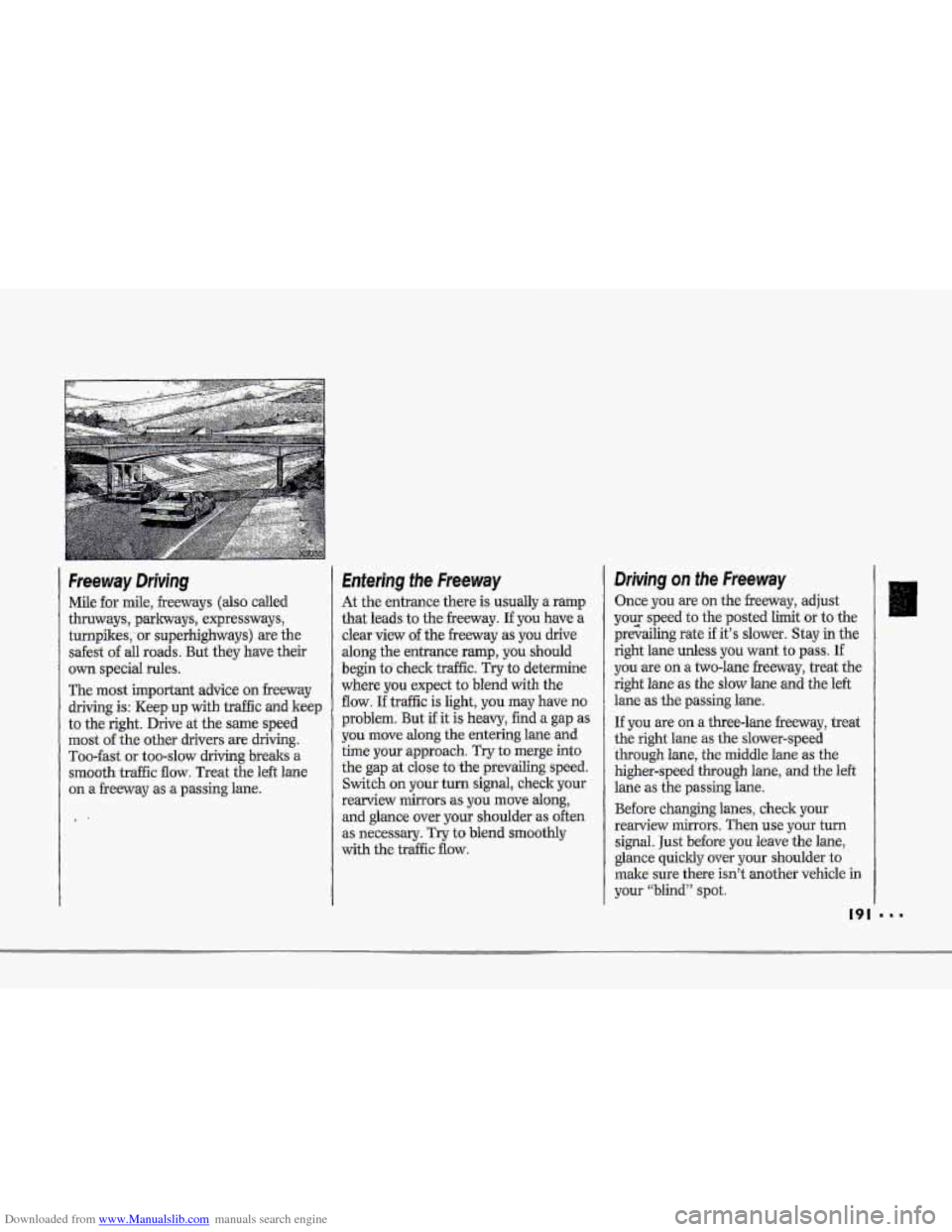
Downloaded from www.Manualslib.com manuals search engine f' " '" ,
Freeway Driviing
Mile--for mile, .freeways (also called
thruways,
parkways, -expressways,
turnpikes,'
or superhighways) are the
safest of all roads. But they have their
own specid rules.
The most important advice on freeway
driving is: Heep.up with tretffic and keep
to the right. Drive at the same speed
most of the ,ot.her drivers are driving-.
Too-fast :or too-slow driving breaks a
mo'oth traffic flow. Treat the left €me
on a :freeway as :a passing lane.
.1-
Entering the Freeway
At the entrance 'there' is usually a ramp
that l;md$ to the freeway. .If you' have a
clear view of the h.my as you drive
along thr: entrance ramp, you .shmild
begin to c.heclr. trdfic. Try to determine
where. you expect to- blend with the
flav. If traffic is light, you may have no
problem. But if it -is heavy, hd.a gap as
you move dong the entering lane &id
time pur qpmach. Tryto merge into
the gap at close to ,the prevailing speed.
Switch on yow: turn signal, check your
rearview mirrors .as you move along,
and.glmce .over your shoulder as often
as necessary. 'Try to blend smoothly
with the. traffic fluw.
DrJvfng on the Freeway
Once you are on the freeway, adjust
your speed
to the posted limit or to,the
prekbg rate if it's slower. Stay in
right fane unless you want to pass. If
you are ma two-lme freeway; treat the
right lane as the sbw lane and the,left
lane the passing lane.
If you are on a thee-lane freeway, treat
the right-
lane as the. slower-speed
through lane, the middle €ane as the
higherdpeed through lane, and the left
lane -as the passing .. lane.
Before changing lanes, check your
rearview minors. Then use YOU turn
signal. Just before you I-cave-the lane,
glance
quickly over pw shoulder to
make sure there isn't another vehicle in
your "blind" spot.
Page 193 of 370
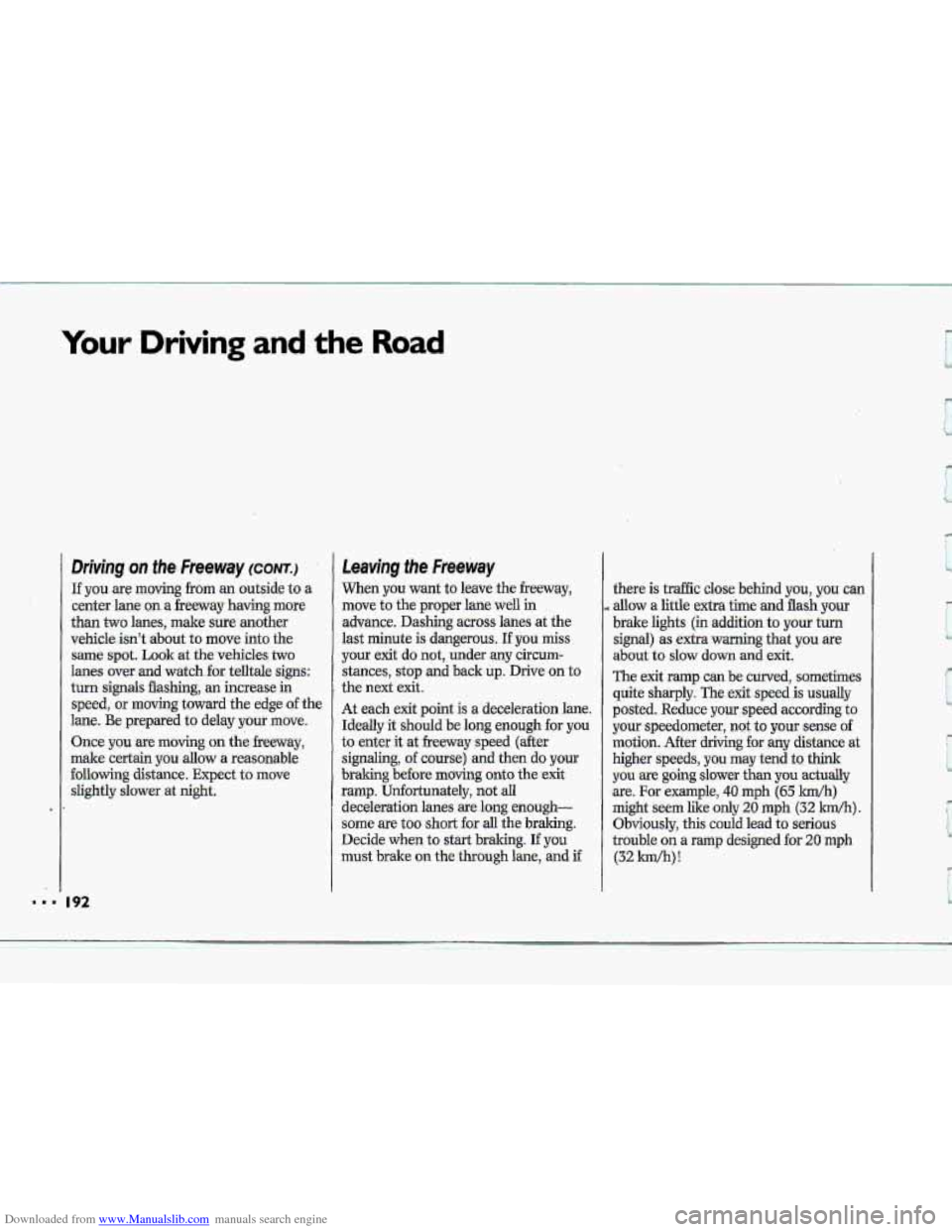
Downloaded from www.Manualslib.com manuals search engine Your Driving and the Road
Driving on the Freeway (CONTJ
~fyou are moving from an outside to a
center lane. on a freeway having more
than two lanes, make sure another
vehic1e;isn't about to move
into the
same spot. Look at the 'vehicles two
lanes over and watch for telltale signs:
turn
signals flashing? an increase in
speed, or
moving toward the edge-of the
lane. Be prepared to delay
your move.
Once you are moving on the freeway,
make certain you allow a reasonable
following distance. Expect
to move
slightly slower at night.
Leaving the Freeway
When you want to leave the freeway,
move to the proper lane well in
advance. Dashing across lanes at the
last minute is dangerous.
If you miss
your exit do not,.under any circum-
stances,
stop and back up. Drive on to
the next
exit.
At each exit point is a deceleration lane.
Ideally it
should be long enough for you
to enter it at freeway speed
(after
signaling, of course) and then do your
braking before
moving onto the ,exit
ramp. Unfortunately, not all deceleration lanes are
long enough-
.some are too short for all the braking.
Decide when
to start braking. If you
must brake on the.through lane, and if
there is traffic close behind you, yau can
allow a little extra tirrie and flash your
brake lights (in addition to your turn
signal)
as extra warning that you are
about to slow down and exit.
The exit ramp
can be curved, sometimes
quite sharply. The exit speed
is usually
posted. Reduce
your speed according to
your speedometer, not-to your sense of
motion. After driving.for any distance at
higher speeds,
you may tend to- think.
you -we going slower than you actually
are. For example,
40 mph (65 I&)
might seem like only 20 mph (32 Wh) .
Obviously, this could lead to serious
trouble on a
ramp designed for 20 rnph
(32 W)!
P
be
Page 194 of 370
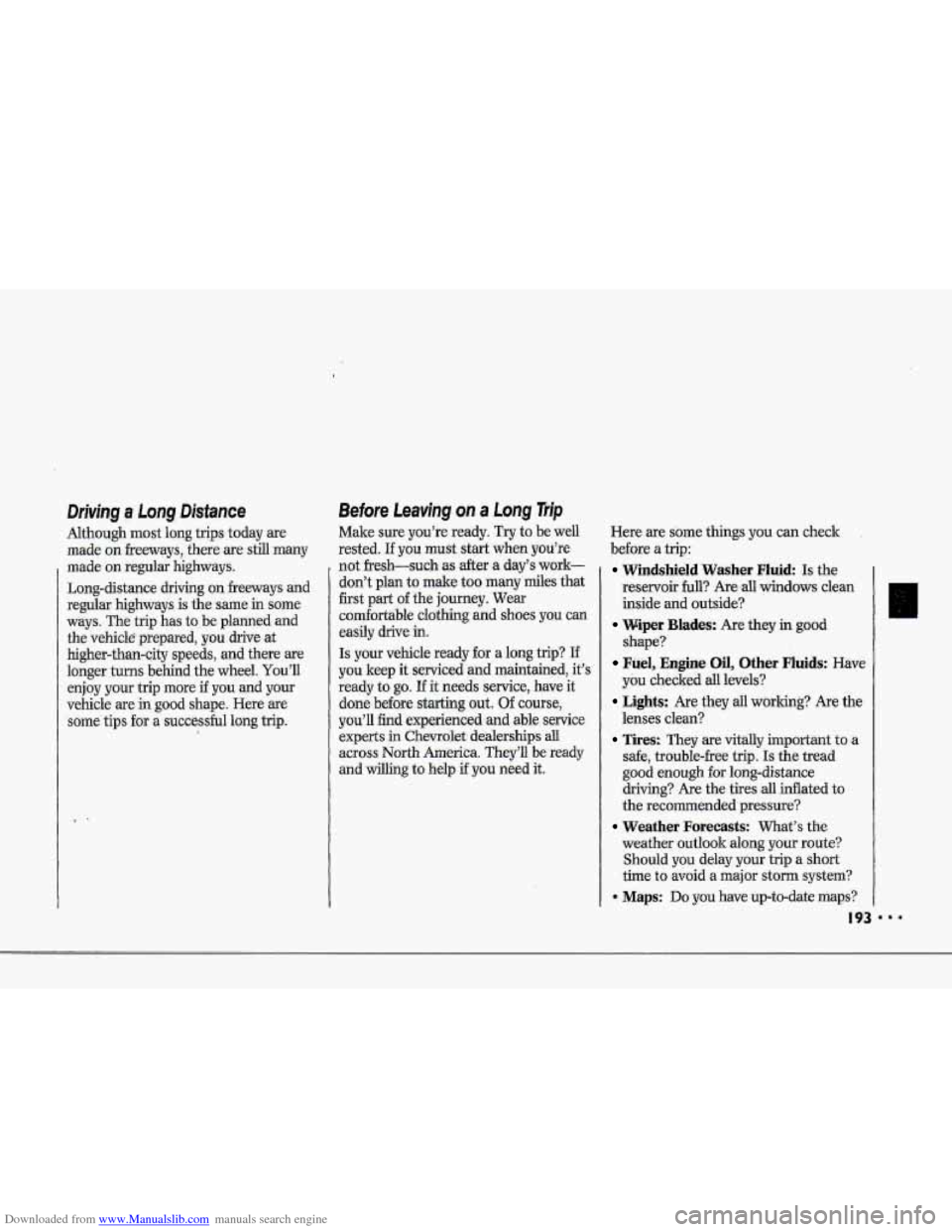
Downloaded from www.Manualslib.com manuals search engine I 9 II
!-
i
Driving a Long Distance
Although most long trips today are
made on freeways, there are still many
made
on regular highways.
Long-distance driving
on freeways and
regular highways is the same in some
ways. The trip has to be planned and
the vehicle prepared, you drive at
higher-than-city speeds, and there are
longer turns behhd the wheel. You’ll
enjoy your
trip more if you and your
vehicle
are in good shape. Here are
some.fips for
a successful long trip.
Before Leaving on a Long Trip
Make sure you’re ready. Try to be well
rested.
If you must start when you’re
not fresh-such as after
a day’s work-
don’t plan to
make too many miles that
first part of the journey. Wear
comfortable clothing and shoes you
can
easily drive in.
Is your vehicle ready for a long trip? If
you keep it serviced and maintained, it’s
ready to
go. If it needs service, have it
done before starting
out. Of course,
you’ll find experienced and able service
experts in Chevrolet dealerships all
across North America. They’ll be ready
and willing to help if you need it. Here
&e some
things you can check
before
a trip:
Windshield Washer Fluid: .Is the
reservoir full? Are ,all windows
clean
inside and outside?
shape?
you checked all levels?
lenses clean?
safe, trouble-hee trip. Is the tread
good enough for lofig-distance
drivhg? Are the tires all inflated to
the recammended pressure?
weather outlook
along your route?
Should you delay your trip a
short
time to avoid a major storm system?
0 Maps: Do you have up-to-date maps?
Wiper Blades: Are they in good
Fuel,, Enme Oil, Other Fluids: Have
Lights: Are they all working? Are the
Tires: They are vitally important to a
Weather Forecasts: What’s the
193
Page 195 of 370
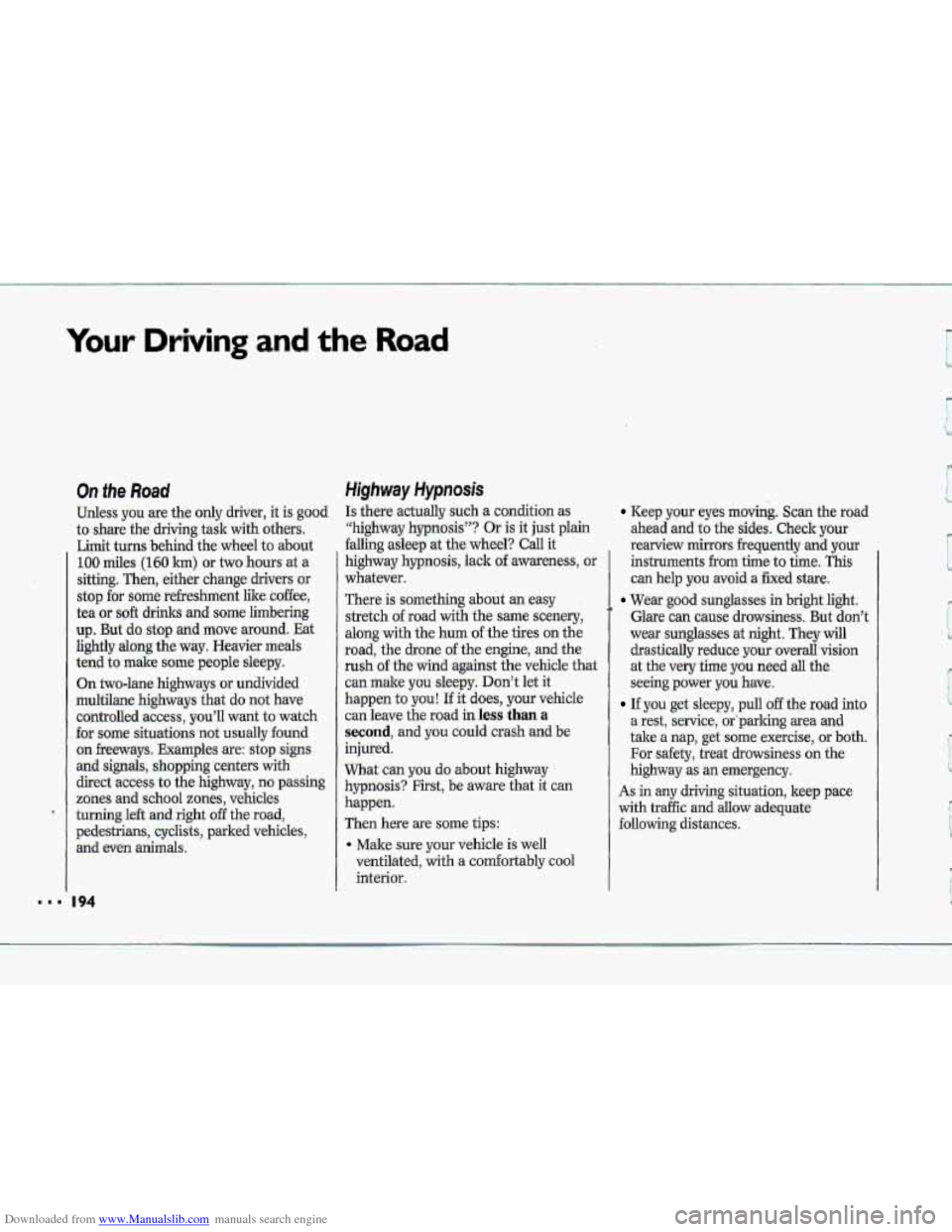
Downloaded from www.Manualslib.com manuals search engine Your Driving and the Road
On She Road
Uidess you are the -only driver, it is good
to share the driving task with others.
Limit turns behind
the wheel to about
100 miles (160 km) Or two hours at a
sitting.-Then, either change drivers ar
stop for some rdreshment like coffee,
tea or
soft drinks and some limbering
up.
But do stop and move around. Eat
lightly along the way. Heavier meals
tend to
mdke some people sleepy.
On two-lane highways or
undivided
multilane highways that do not have
controlled .access,.you’ll
wmt to watch
for some situations :not usustlly found
on freeways. Examples: are: stop signs
and signals, shopping tenters with
direct access
to the highway, no passing
zones and school zones, vehicles
turning
le& and- right off the-road,
pedestrians, cyclists, parked vehicles, and even a&&.
Highway Hypnosis
Is thete-actually such a condition as
“highway hypnosis”? Or
is it just plain
falling asleep at the wheel? Call it
highway hypnosis, lack
of awareness, or
whatever.
There is
something about an easy
stretch
of road with the same scenery,
along with the
hum of the tires on the
road, the drone of the engine; and the
rush of the wind against the vehicle that
can make you sleepy. Don’t let it
happen
to you! If it does, your vehicle
can leave the road in less than a
second, and you could crash and be
injured.
What can you do about highway
hypnosis? First, be aware that it can
happen.
Then here
are some tips:
4 Make sure your vehicle is well
ventilated,
with a comfortably cool
interior.
Keep your eyes moving. Sca.n the road
ahead and
-to the sides. Check your
rearview mirrors frequently and your
instruments from time to time. This
can help you avoid
a fixed stare.
Wear good sunglasses in bright light.
Glare can cause drowsiness. But
don’t
wear sunglasses at night. They will.
drastically reduce-your,overall.~sion
at the very time you need all the.
seeing power
you have.
If you get sleepy, pull off the road into
a rest, service, &‘parking area and
take a nap, get so.me exercise, or both.
For safety, treat drowsiness on the
highway
as an emergency.
As in any driving situation, keep pace
with traffic and allow adequate
foIlowing distances.
Page 196 of 370
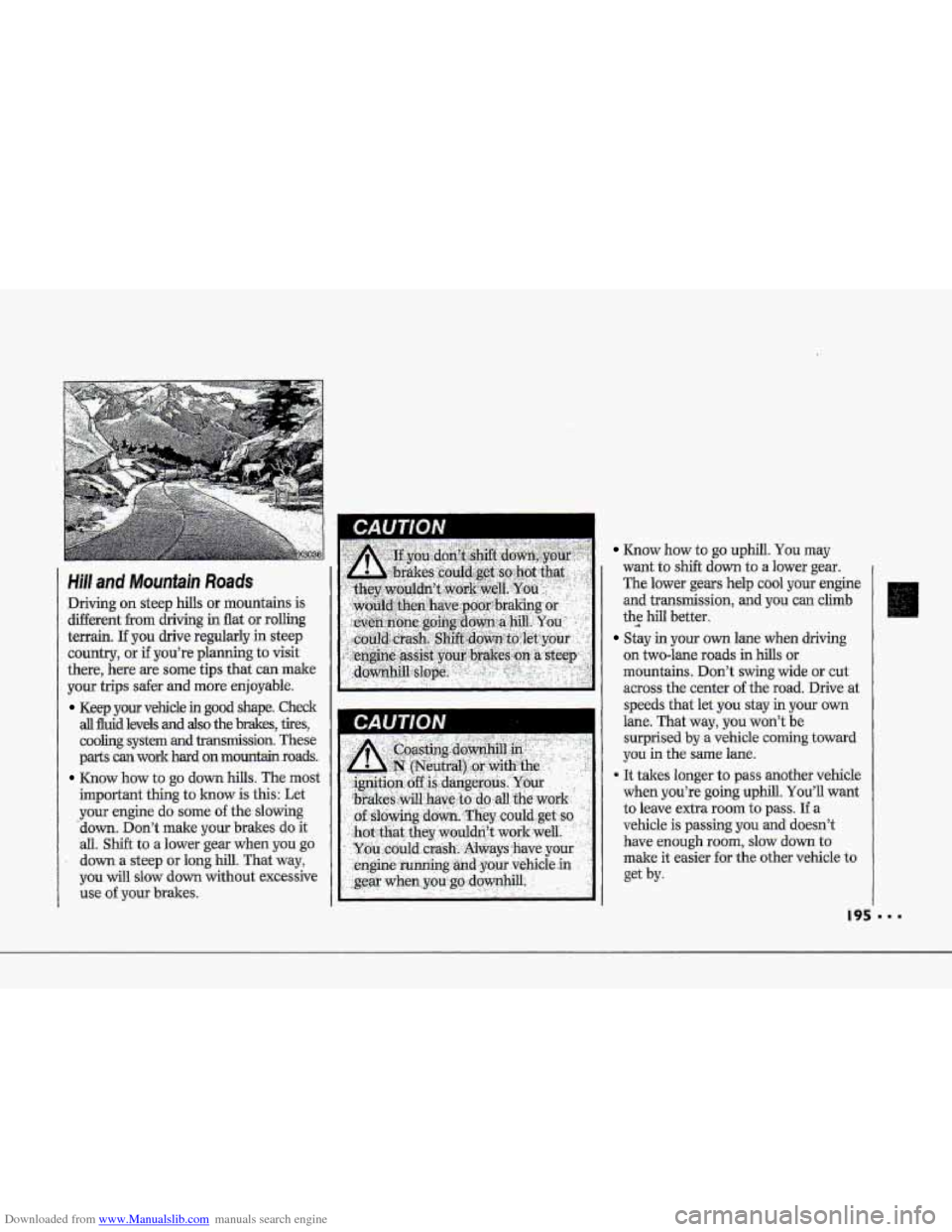
Downloaded from www.Manualslib.com manuals search engine f
F"
Hin and Mounfain Roads
Driving on steep hills or mountains is
dif€erent fram driving in flat or rolling
terrain. If you drive regularly in steep
country,
or if you're planning to visit
there, here are -some tips that can make
your trips safer and.more enjoyable.
Keep your vehicle in good shape. Check
all fluid levels and also the brakes, tires,
cooling system and transmission. These
parts can work hard on mountain roads.
Know how to go down hills. The most
important thing to how is this: Let
your engine do. some of the slowing
'down. Don't make your brakes do it
all. Shift to a lower gear when you go
down .a steep or long hill. That way,
you will slow down without excessive
use of your brake-s.
Know how to go uphill. You may
want to shift dawn to a lower gear.
The lower gems help cool your engine
and transmission, and you can clin-ib
the *f hiU better.
Stay in your own lane when driving
on two-lane roads in hills or
mountains. Don't swing wide .or cut-
across. the .center of the road. Drive at
speeds that-let-you stay 'in your own
lae. That way, you won't be
surprised by,a vehicle- coming toward
you
in the same lane.
* It takes longer to pass another vehicle-
when you're going uphill. You'll want
to leave extra room to pass. If a
vehicle is passing you and doesn't
have enough room, slow down to
make it easier for the other vehicle to
get by.
Page 197 of 370
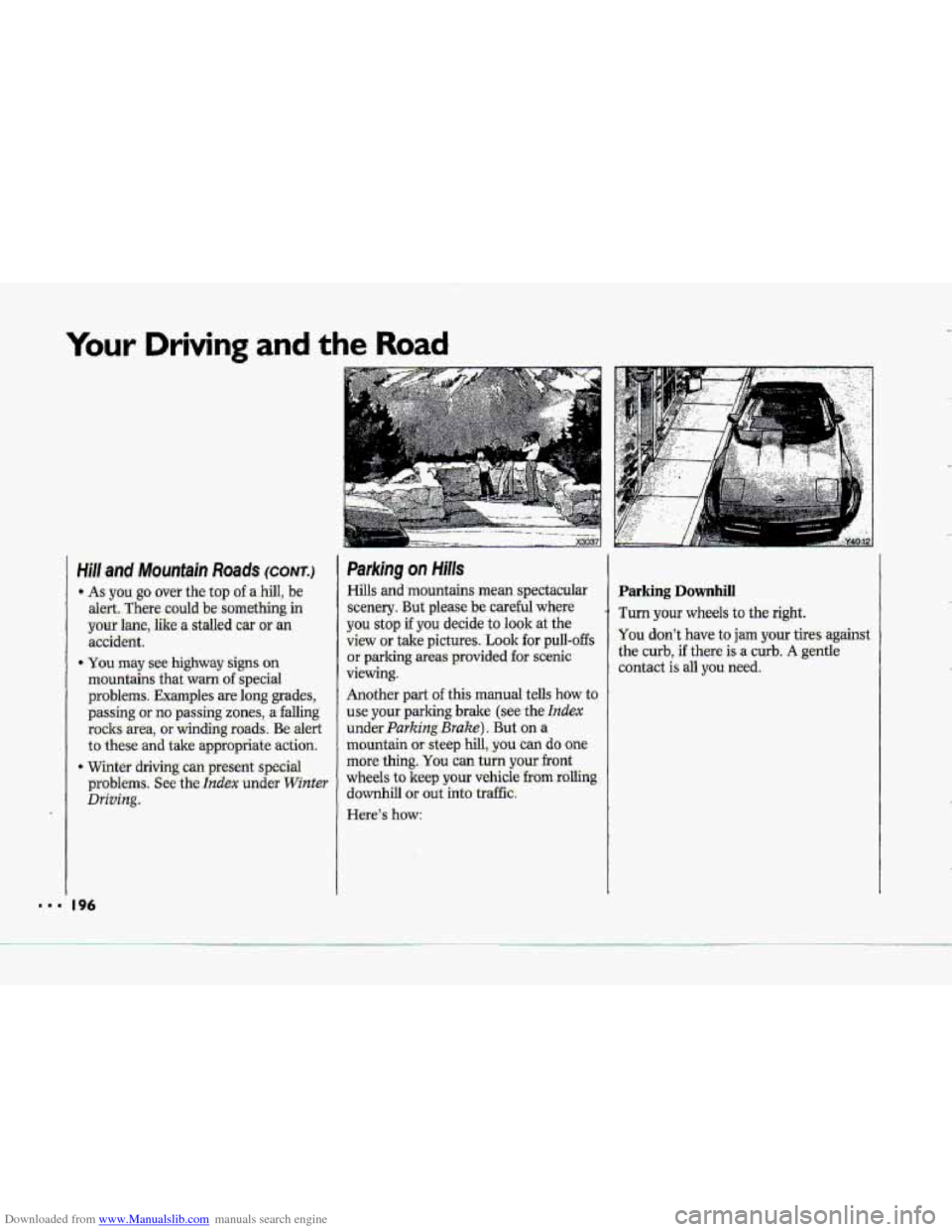
Downloaded from www.Manualslib.com manuals search engine Your;briving and. , ,., the Road
Hill an.d Mountain Roads (C.ONT.)
*- As you go over the top of a hilI, be
alert. There could
be something in
your lane, like a stalled car or an
accident.
* You may see highway signs 0x1
mountains that warn of special
problems. Examples are long
grades,
passing or na passing zones, a falling
rocks area, or winding roads. Be alert
to these and take appropfiate action.
Winter driving can present special
problems. See the .Index under Winteu.
Driving.
Parking on UMs
Hills and mountains mean spectacular
scenery. But please be car.eful where
you stop if you decide to look at the
view or t.ake pictures. .Look €or pull-offs
or parking areas .provided for scenic
viewing.
Another part of this manual tells .how to
use
your parking brake (see the Index
under Fuiking Brake). But on a
mountain or steep hill, you can do one
more thing. You can turn your kont
wheels
to keep your vehicle frorn.r.olling
downhill or out .into traffic.
Here'.s how:
Parking Downhill
Turn your wheels to the right.
You don't have to jam your tires against
the curb, if there is a curb. A-gentle
c6xltact
is all you need.
Page 198 of 370
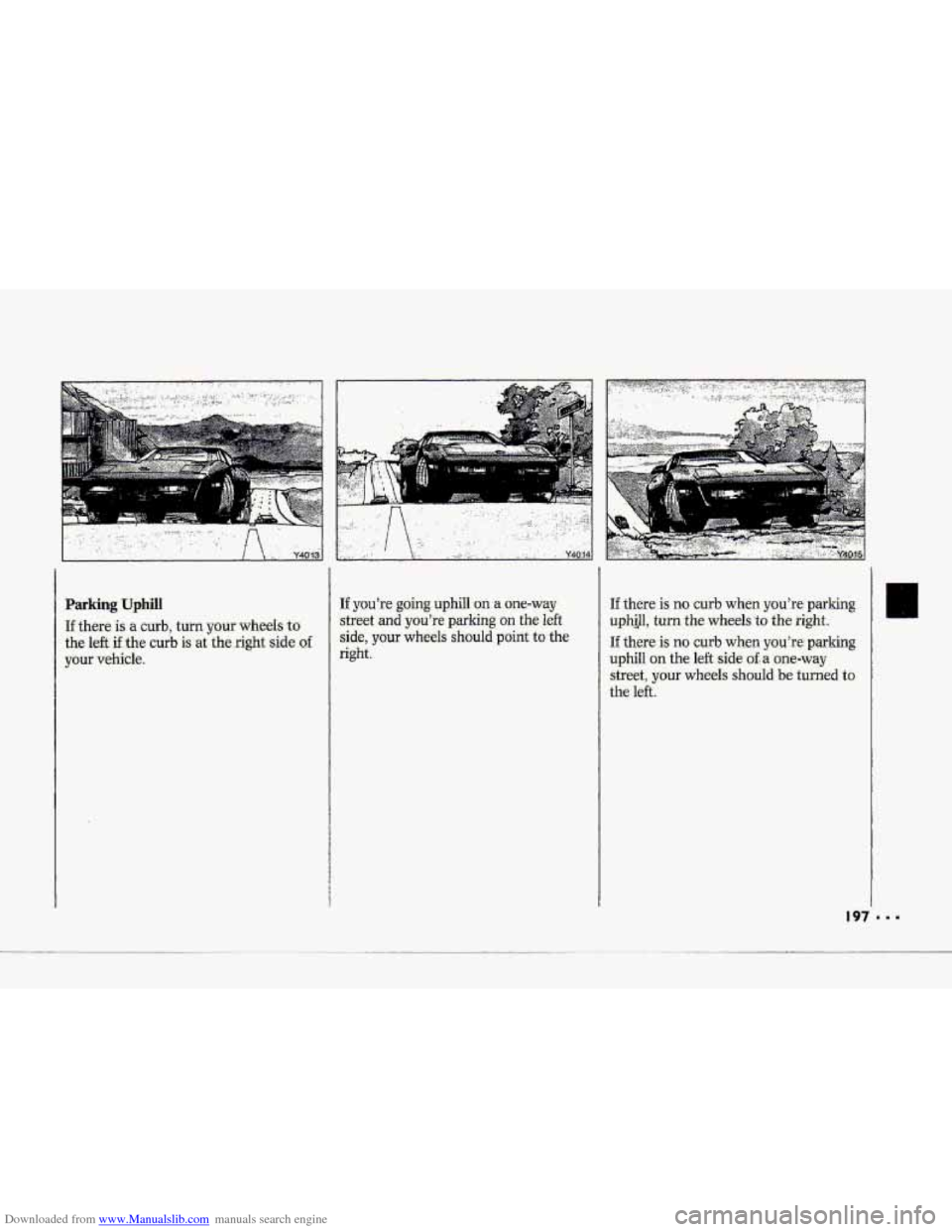
Downloaded from www.Manualslib.com manuals search engine Parkifig Uphill
If there is a -curb, turn. your wheels to
the left ifthe curb is at the.right side :of
your vehicle.
If you’re going uphill on a one-way
street aad you’re parldng. on the,left
side, your wheels should poifit to the
right.
If there is no curb when yo,u’re parking
uph.j,ll, turn. the wheels to the right.
If there is no curb when you’re- parking
-uphill Qn the 1efi:side oh one-%ay
street, .your wheels should be turned to
the left.
c
Page 199 of 370
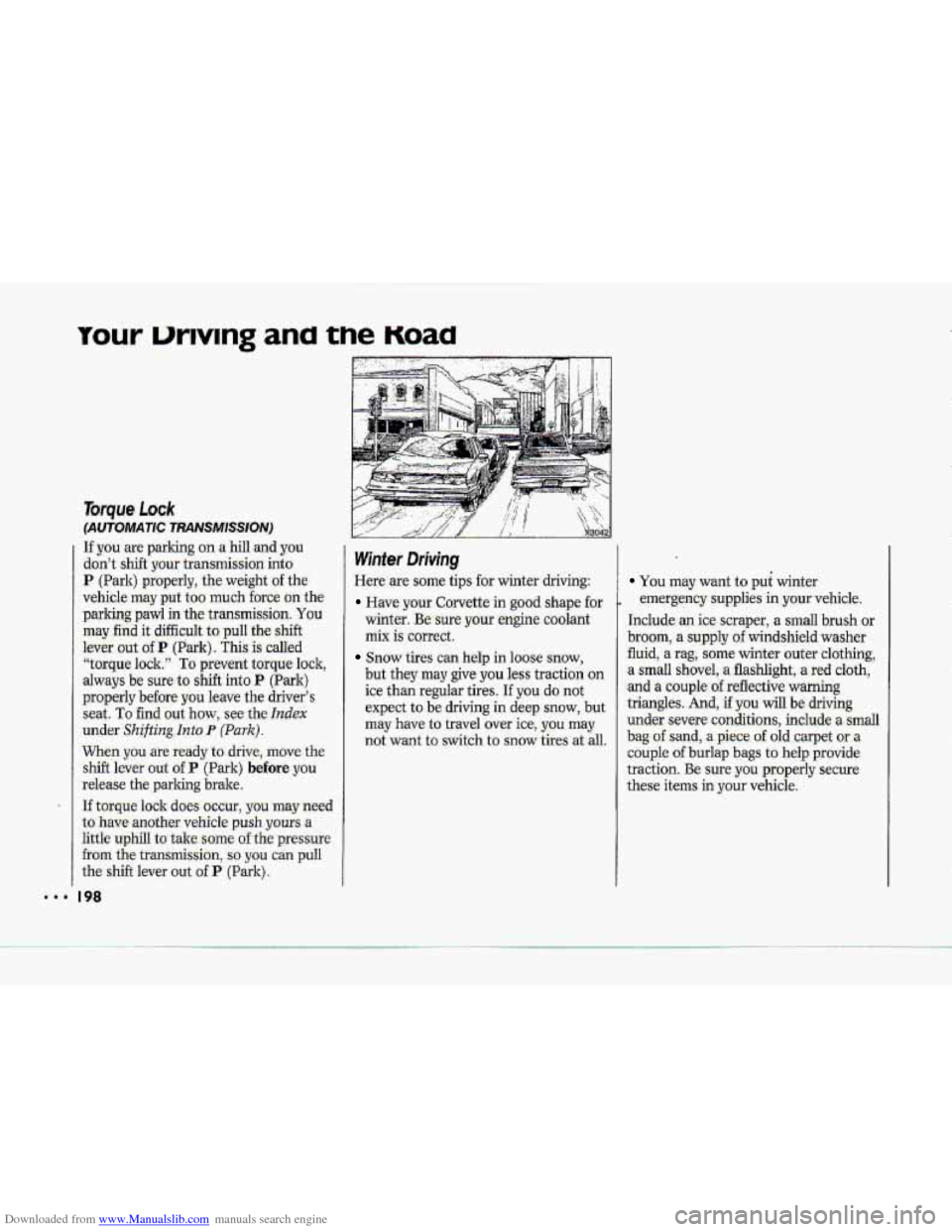
Downloaded from www.Manualslib.com manuals search engine your urlvlng ana tne Koaa
Torque Lock
(AUTQMATIC TRANSMISSION)
If you are parking on a hill and you
don’t shift your transmissian into
P (Park) properly, the weight of the
vehicle may put
too much force on the
parking pawl in the transmission. You
may find it difficult to pull the shift
lever out of
P (Ihrlr). This is called
“torque
lock.” To prevent torqu’e lock,
always
be sure to shift into P (Park)
properly before you leave the driver’s
seat.
To find out how, see the Index
under Shifting Into P (Park).
When you are ready to drive, move the
shift lever out
of P (Park) before you
release the parking brake.
If torque lock does occur, you may need
to. have another vehicle push yours a
little uphill to take some of-the pressure
from the transmiss.ion, ‘so you can pull
the
shifi lever out of P (Park).
I98
Winter Driving
Here are some tips for winter driving:
Have your Corvette in good shape for
winter.
Be sure your engine coolant
mix is correct.
Snow tires can help in loose snow,
but they may give you less traction on
ice than regular tires. If you do not
expect to be driving
in deep snow, but
may have
to travel over ice, you may
not want to switch to
snow tires at .all.
YOU may want to put winter
emergency supplies in your vehicle.
Include
an ice scraper, a small brush or
broom, a supply of windshield washer
fluid, a rag, some winter outer clothing,
a small shovel, a flashlight, .a red cloth,
and a couple of reflective warning
triangles. And, if-you will be driving
under severe conditions,
include a small
bag of sand, a piece of old carpet or a
couple of burlap bags to help provide
traction. Be sure you properly secure
these items in your vehicle.
Page 200 of 370
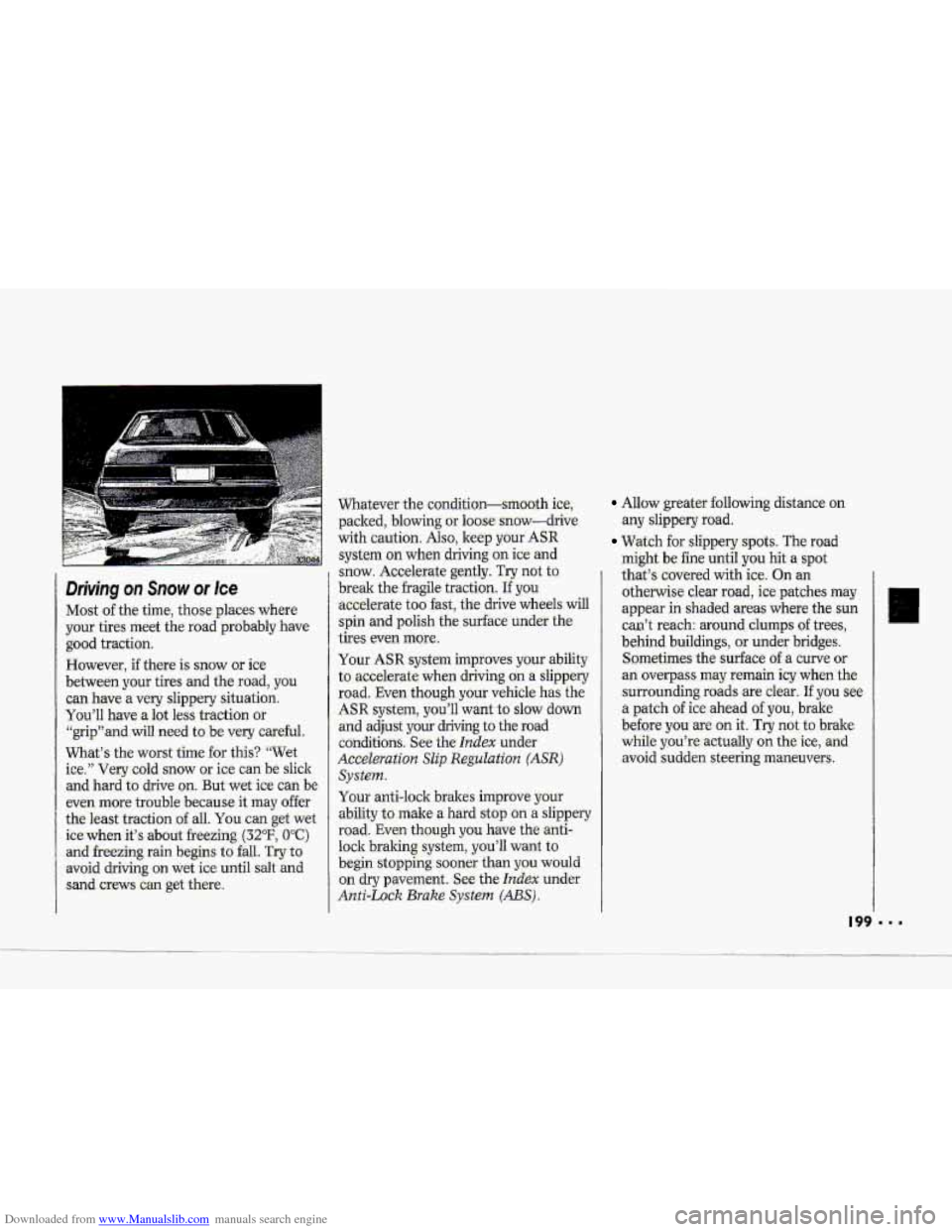
Downloaded from www.Manualslib.com manuals search engine m-4.
Driving on Snow or Ice
Most of the time, those ,places where
y6ur tires meet the road pr:obably
have
good traction.
However,
if there is mow or ice
betwe.en
you^ tires and the road, you
can have a very slippery Situati-on.
You’ll have alot lcss traction Crr
“@p”and -will need t.Cbe very careful.
What’s the wors;t- time for this? “Wet
ice;” Very cold
mow or ice can be slick
and hard to drive on. But-wet. ice can be
even more trouble .because it-may offer
the least
traction .o% all. You c.an iet wet
ice-when -it% about freezing (WF, PC)
2nd heezing pain begins- to fall. Try to
avoid driving an wet ice until salt, and
sand crews ean get there.
Allow greaterfollowing distafice on
any slippery road.
Watch for slippery spots. The road
might be fine until you hit a- spot
that% covered with ke. On an
othehvise dear roadyice patches may
appear in shaded areas- whefe. the sun
can’t reach: around clumps crf trees,
behind buildings, or under bridges.
Sometimes-
the &dace of. a curve or
an overpass may remain icy’when. the
surrounding roads are dear. If you see
a patch of ic.e ahead of you, brake
befgre you are on it. Try not to, brakc
while you?e:actu.al€y on the ice, and.
avoid
sudden steering maneuvers,